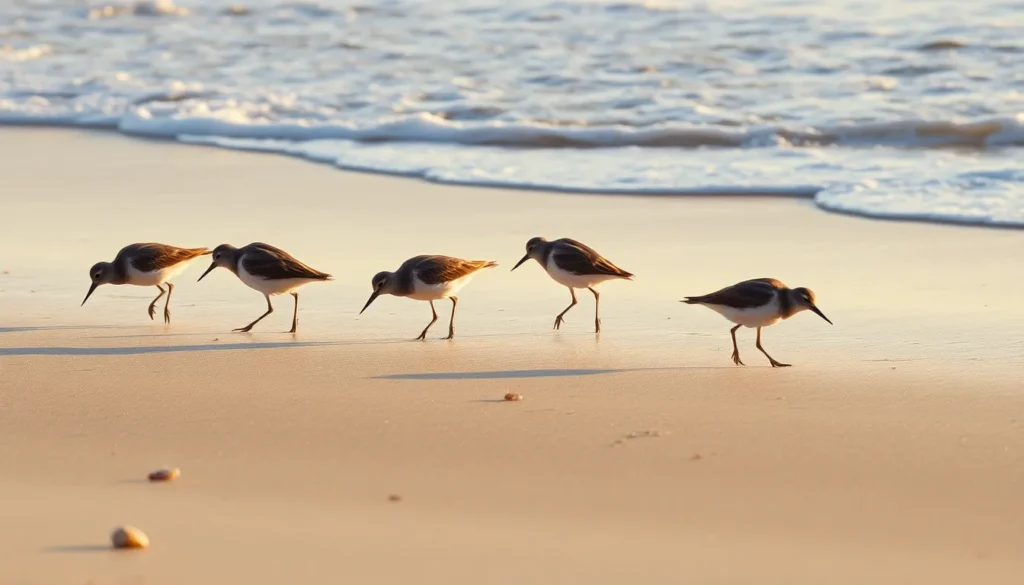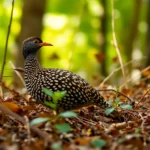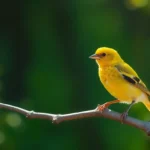Picture this: you’re strolling along a pristine shoreline when dozens of small birds suddenly scatter across the sand like feathered ballet dancers. These aren’t just any ordinary shorebirds – they’re sandpipers, and they’re putting on one of nature’s most captivating performances right before your eyes.
We’ve all witnessed these remarkable little athletes darting in and out with the waves, but there’s so much more to discover about these incredible creatures. From their impressive migration journeys that span continents to their unique feeding behaviors that’ll leave you amazed, sandpipers represent one of the most fascinating bird families on our planet.
Whether you’re a seasoned birdwatcher or someone who’s simply curious about the wildlife around you, understanding these remarkable shorebirds will transform how you experience any coastal adventure. Let’s jump into the extraordinary industry of sandpipers and uncover what makes them such exceptional members of the avian community.
What Is a Sandpiper Bird
Sandpipers belong to the Scolopacidae family and represent one of the most diverse groups of shorebirds across the globe. These small to medium-sized birds measure between 6 to 12 inches in length and weigh approximately 0.5 to 8 ounces depending on the species. Over 85 distinct sandpiper species exist worldwide including the Least Sandpiper, Dunlin, and Sanderling.
Physical characteristics define sandpipers through their slender builds, long pointed wings, and distinctive bill shapes. Their bills vary significantly among species – some feature straight thin beaks while others display curved or slightly upturned variations. Most sandpipers exhibit mottled brown, gray, and white plumage that provides excellent camouflage against sandy shorelines and mudflats.
Habitat preferences span coastal areas, wetlands, mudflats, and inland water bodies across every continent except Antarctica. Sandpipers thrive in environments where soft substrates allow easy probing for food. Tidal zones, salt marshes, and shallow freshwater areas serve as primary feeding grounds throughout different seasons.
Feeding behavior centers on their remarkable foraging abilities using specialized bills to extract invertebrates from sand and mud. Sandpipers consume marine worms, small crustaceans, mollusks, and insects by probing depths ranging from surface level to 3 inches below ground. Their sensitive bill tips detect prey movement through tactile sensors called Herbst corpuscles.
Migration patterns showcase some of nature’s most impressive long-distance journeys. Arctic-breeding sandpipers travel over 9,000 miles annually between breeding and wintering grounds. Red Knots demonstrate exceptional endurance by flying nonstop for 4,000 miles during peak migration periods while relying on fat reserves accumulated at stopover sites.
Physical Characteristics and Identification
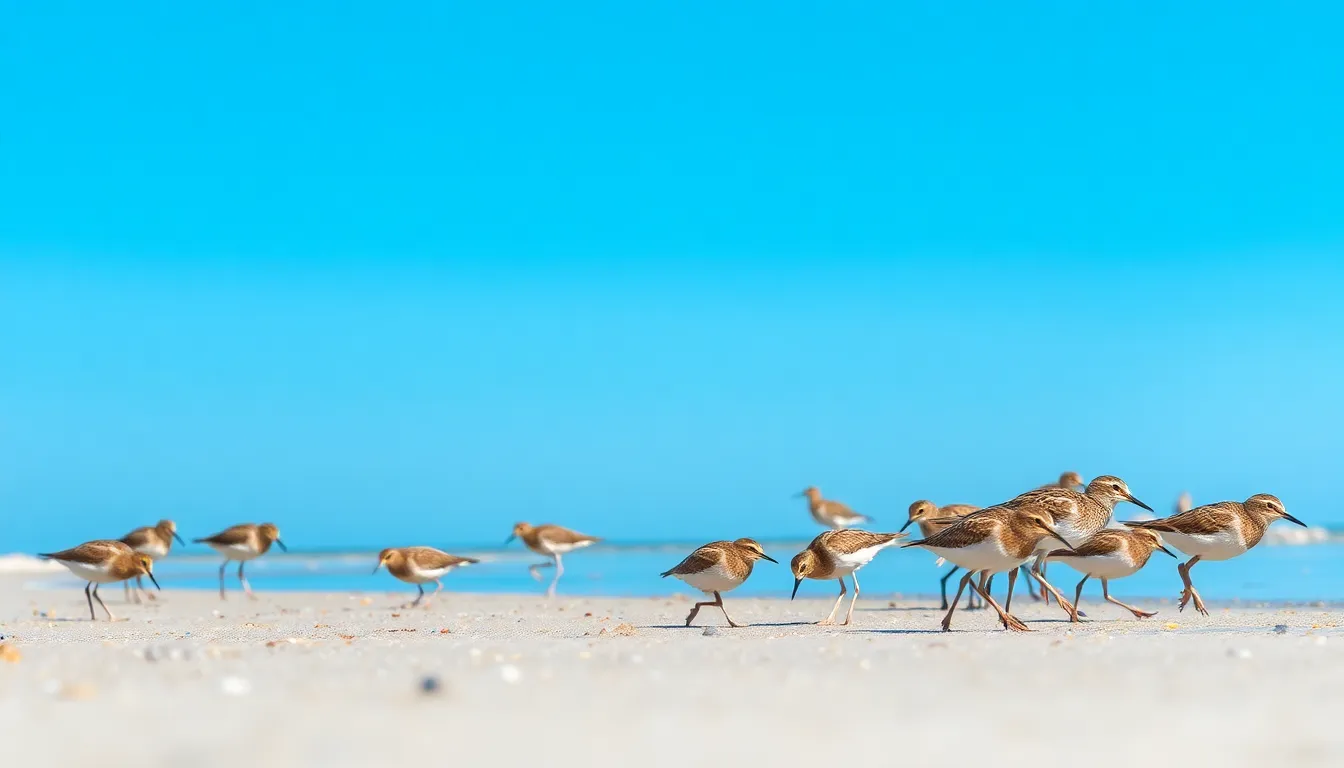
Sandpiper physical features create a distinctive profile that makes these shorebirds recognizable across diverse coastal environments. We can identify different sandpiper species by examining their size variations, plumage patterns, and specialized anatomical adaptations.
Size and Body Structure
Sandpiper body dimensions range from 6 to 12 inches in length, with weight variations spanning 0.5 to 8 ounces depending on species. Compact builds characterize smaller species like the Least Sandpiper, which measures approximately 6 inches and weighs under 1 ounce. Medium sized varieties such as the Dunlin reach 8.5 inches with streamlined torsos that optimize flight efficiency during long migrations.
Large sandpiper species including the Red Knot extend up to 11 inches and display robust chest muscles that power their extensive journeys. Wing shapes remain consistently pointed across all species, creating high aspect ratios that reduce energy expenditure during flight. Tail lengths stay proportionally short, typically measuring 25% of total body length to maintain aerodynamic balance.
Plumage and Coloration
Breeding plumage transforms sandpiper appearance through vibrant rufous, chestnut, and black markings that contrast sharply with their winter coloration. We observe striking seasonal changes in species like the Dunlin, which develops bold black belly patches and russet back feathers during spring months. Winter plumage shifts to muted gray and brown tones that provide excellent camouflage against sandy beaches and mudflats.
Juvenile sandpipers display distinctive feather edging with buff or white borders that create scaled patterns across their upperparts. Sexual dimorphism appears minimal in most species, though females often measure slightly larger than males. Subspecies variations produce subtle differences in plumage intensity, with northern populations typically showing darker coloration than southern counterparts.
Bill and Leg Variations
Bill shapes reflect specialized feeding strategies, ranging from short straight bills in species like the Sanderling to curved bills in the Dunlin that exceed 1.5 inches in length. Probe feeding species develop longer bills that reach 2 to 3 inches, allowing access to deeper invertebrates buried in substrate layers. Bill sensitivity increases through nerve endings concentrated in the tip, enabling tactile foraging in murky water conditions.
Leg colors vary from yellow in the Least Sandpiper to black in the Dunlin, with intermediate species showing greenish or grayish tones. Leg length correlates with foraging depth preferences, as longer legged species wade into deeper water while shorter legged varieties remain on dry sand. Toe structure includes partial webbing in some species, though most sandpipers lack important webbing compared to true water birds.
Sandpiper Species and Varieties
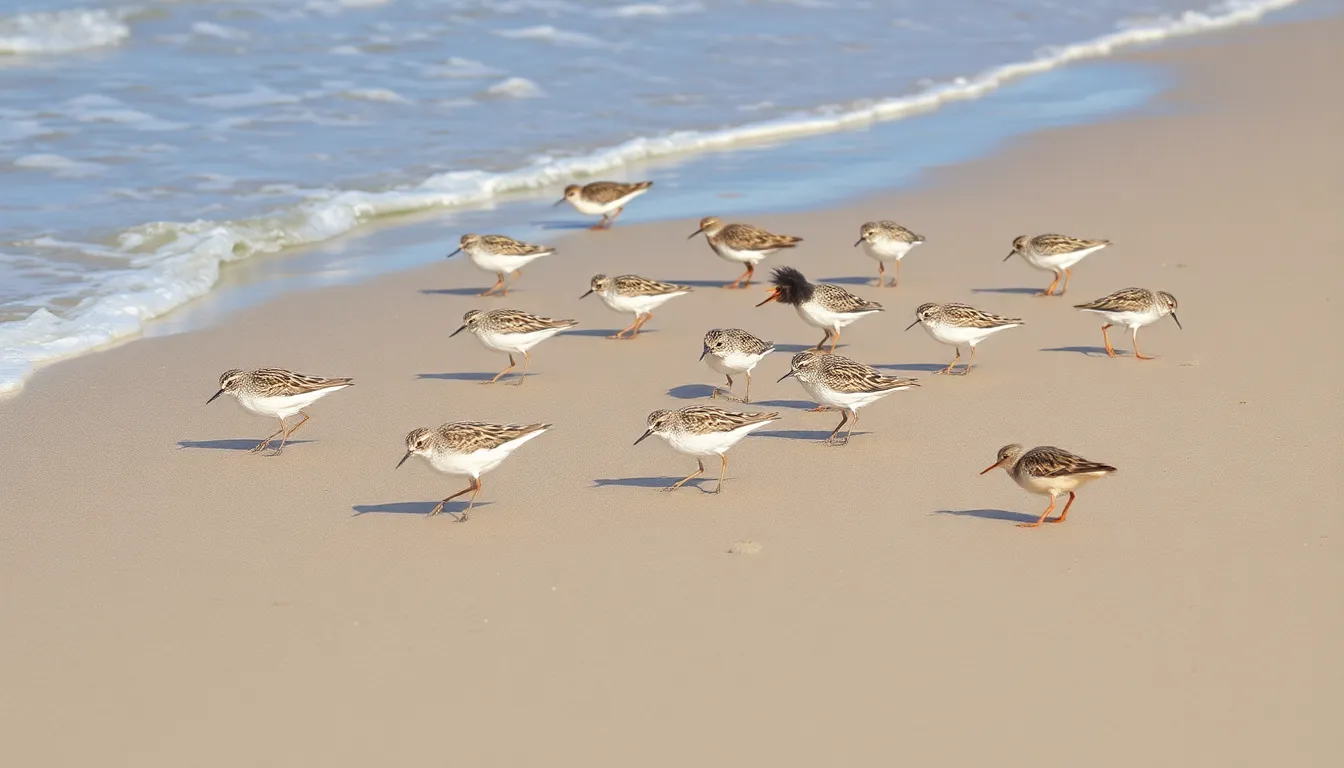
Sandpiper diversity spans across 85+ distinct species within the Scolopacidae family. Each species exhibits unique adaptations that reflect specialized ecological niches and geographic distributions.
Common Sandpiper Species
We encounter many sandpiper species across different habitats, with several standing out as particularly widespread and recognizable.
Least Sandpiper (Calidris minutilla) represents North America’s smallest shorebird at 5-6 inches in length. These compact birds weigh approximately 0.7 ounces and display yellowish legs that distinguish them from similar species. Breeding adults show rusty brown upperparts with dark streaks, while winter plumage shifts to grayish brown tones.
Dunlin (Calidris alpina) measures 7-9 inches long with distinctive curved bills adapted for probing soft substrates. During breeding season, males develop characteristic black belly patches contrasting with rufous backs. Winter populations gather in massive flocks exceeding 10,000 individuals along Pacific and Atlantic coastlines.
Sanderling (Calidris alba) exhibits remarkable behavioral patterns, constantly chasing retreating waves to capture exposed marine invertebrates. These 7-8 inch birds transform from bright rusty breeding plumage to pale gray winter coloration. Their specialized feeding technique involves rapid sprinting along wave edges.
Spotted Sandpiper (Actitis macularius) demonstrates unique teetering behavior while foraging along freshwater shores. Adults display prominent black spots across white underparts during breeding season. Body length reaches 7-8 inches with distinctive wing-beating flight patterns close to water surfaces.
Red Knot (Calidris canutus) showcases extraordinary migration distances spanning 9,300 miles annually. These robust 9-10 inch birds depend heavily on horseshoe crab eggs during Delaware Bay stopover periods. Breeding plumage features bright reddish underparts transitioning to mottled gray winter appearance.
| Species | Length (inches) | Weight (ounces) | Key Features |
|---|---|---|---|
| Least Sandpiper | 5-6 | 0.7 | Yellow legs, smallest North American shorebird |
| Dunlin | 7-9 | 1.8-2.4 | Curved bill, black belly patch in breeding |
| Sanderling | 7-8 | 1.2-2.6 | Wave-chasing behavior, pale winter plumage |
| Spotted Sandpiper | 7-8 | 1.2-1.8 | Black spots, distinctive teetering motion |
| Red Knot | 9-10 | 4.4-7.8 | Long-distance migrant, horseshoe crab dependence |
Regional Distribution Differences
Geographic variations create distinct sandpiper communities across global regions, with species compositions reflecting local habitat conditions and migration routes.
Arctic Breeding Grounds support 23 sandpiper species during summer months, including Buff-breasted Sandpipers and Baird’s Sandpipers. Tundra environments provide abundant invertebrate resources during brief breeding windows. Temperature extremes limit breeding seasons to 60-90 days annually.
Pacific Flyway hosts concentrated migrations involving 15 primary sandpiper species. Western Sandpipers dominate with populations exceeding 3.5 million individuals. Stopover sites like San Francisco Bay support 95% of Pacific coast sandpiper populations during peak migration periods.
Atlantic Coastal Regions feature specialized communities adapted to salt marsh environments. Semipalmated Sandpipers comprise 70% of Atlantic flyway populations. Delaware Bay serves as critical habitat for 80% of Red Knot populations during northbound migrations.
Inland Wetland Systems attract different species compositions compared to coastal areas. Solitary Sandpipers prefer freshwater habitats with vegetated margins. Stilt Sandpipers concentrate in shallow prairie potholes during migration periods.
European Distributions include distinct subspecies like Dunlin variations across Scandinavian breeding grounds. Purple Sandpipers specialize in rocky coastlines unavailable to other species. Mediterranean regions support wintering populations of 12 sandpiper species.
Asian Pacific Regions contain 28 sandpiper species with many endemic to exact island chains. Spoon-billed Sandpipers face critical endangerment with populations below 500 breeding pairs. Coastal development threatens 85% of traditional stopover locations across the region.
Habitat and Distribution
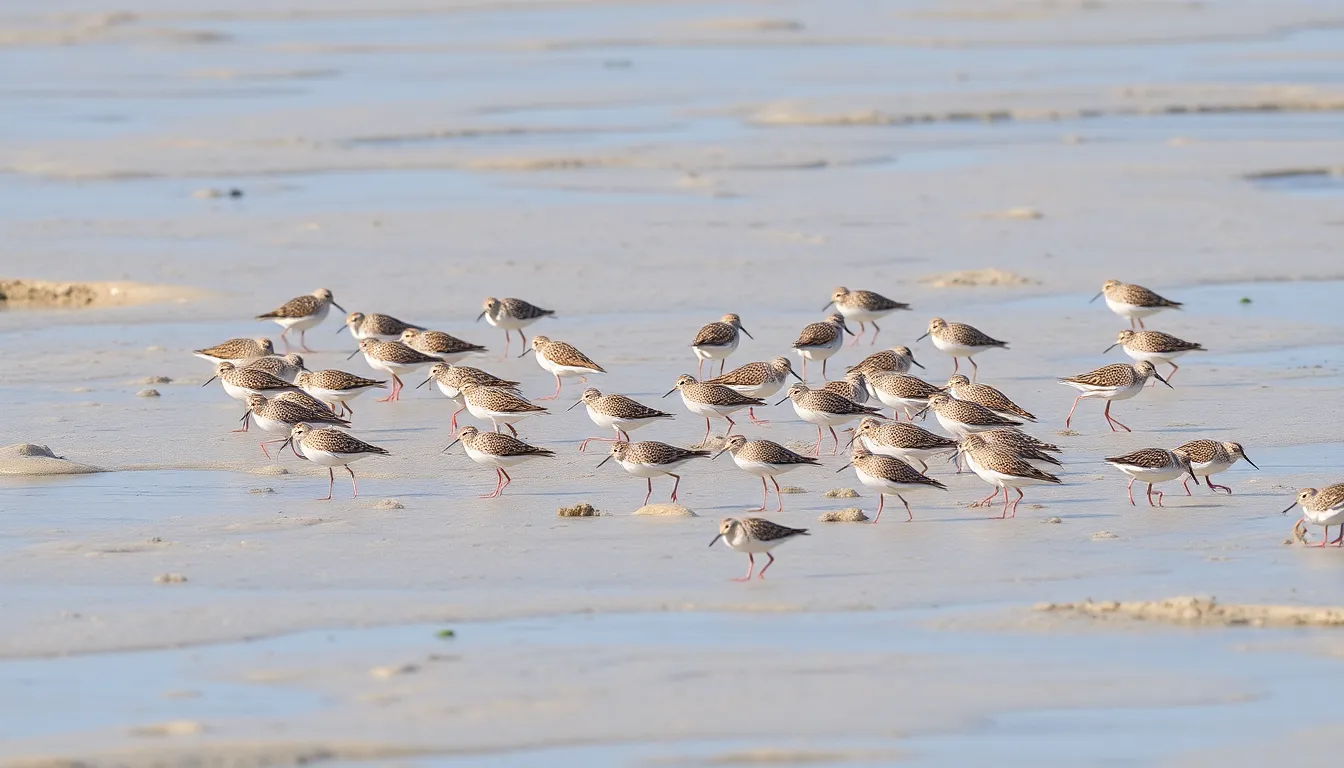
Sandpiper birds inhabit diverse ecosystems across six continents, establishing populations from Arctic tundra to tropical shorelines. These adaptable shorebirds demonstrate remarkable geographic flexibility, occupying environments that provide optimal foraging opportunities and nesting conditions.
Preferred Environments
Coastal mudflats serve as primary sandpiper habitats, offering abundant invertebrate prey within soft sediments. These productive zones support dense concentrations of polychaete worms, amphipods, and small mollusks that constitute core dietary components.
Salt marshes provide essential staging areas during migration periods, with high salinity levels creating specialized ecosystems. Sandpipers exploit tidal pools and creek channels within these environments, accessing crustaceans and marine insects.
Rocky shorelines attract species with specialized feeding adaptations, particularly those capable of extracting prey from crevices and barnacle clusters. Purple Sandpipers exemplify this ecological niche, foraging among wave-washed rocks throughout winter months.
Inland wetlands support important sandpiper populations during breeding seasons and migration stopovers. Prairie potholes, lake margins, and flooded agricultural fields offer freshwater invertebrates and nesting substrates.
Tundra regions across Alaska, northern Canada, and Siberia host breeding colonies during brief Arctic summers. These areas provide insect abundance, minimal human disturbance, and extended daylight hours for intensive feeding.
| Environment Type | Primary Species | Key Features |
|---|---|---|
| Coastal Mudflats | Dunlin, Sanderling | Soft substrate, invertebrate density |
| Salt Marshes | Semipalmated Sandpiper | Tidal influence, staging areas |
| Rocky Shores | Purple Sandpiper | Crevice foraging, winter habitat |
| Inland Wetlands | Least Sandpiper | Freshwater systems, breeding sites |
| Arctic Tundra | Red Knot, Turnstone | Breeding grounds, insect abundance |
Migration Patterns
Sandpiper migration routes span three major flyways connecting Arctic breeding grounds with wintering areas across four continents. These pathways help movements covering distances exceeding 15,000 miles annually for some species.
The Pacific Flyway channels millions of sandpipers along North American coastlines from Alaska to Chile. Copper River Delta in Alaska serves as a critical stopover, hosting over 20 million shorebirds during spring migration peaks.
Atlantic Flyway migration connects northeastern breeding areas with Caribbean and South American destinations. Delaware Bay represents a vital refueling station where Red Knots depend entirely on horseshoe crab egg availability during May migration windows.
Central Flyway guides sandpipers through interior continental routes, utilizing prairie wetlands and Great Plains water bodies. This pathway supports species breeding in central Arctic regions while connecting to Gulf Coast wintering grounds.
East Atlantic Flyway links European and Asian breeding populations with African wintering territories. Wadden Sea serves 12 million shorebirds annually, functioning as Europe’s most important staging area.
Timing patterns vary significantly among species, with early migrants departing breeding areas by mid-July while late species remain until September. Adults typically precede juveniles by 2-4 weeks, establishing optimal feeding territories before inexperienced birds arrive.
Distance variations reflect body size adaptations, with larger species like Red Knots completing 9,300-mile nonstop flights between staging areas. Smaller sandpipers make frequent stops every 300-500 miles, requiring higher quality habitat density along migration corridors.
Behavior and Diet
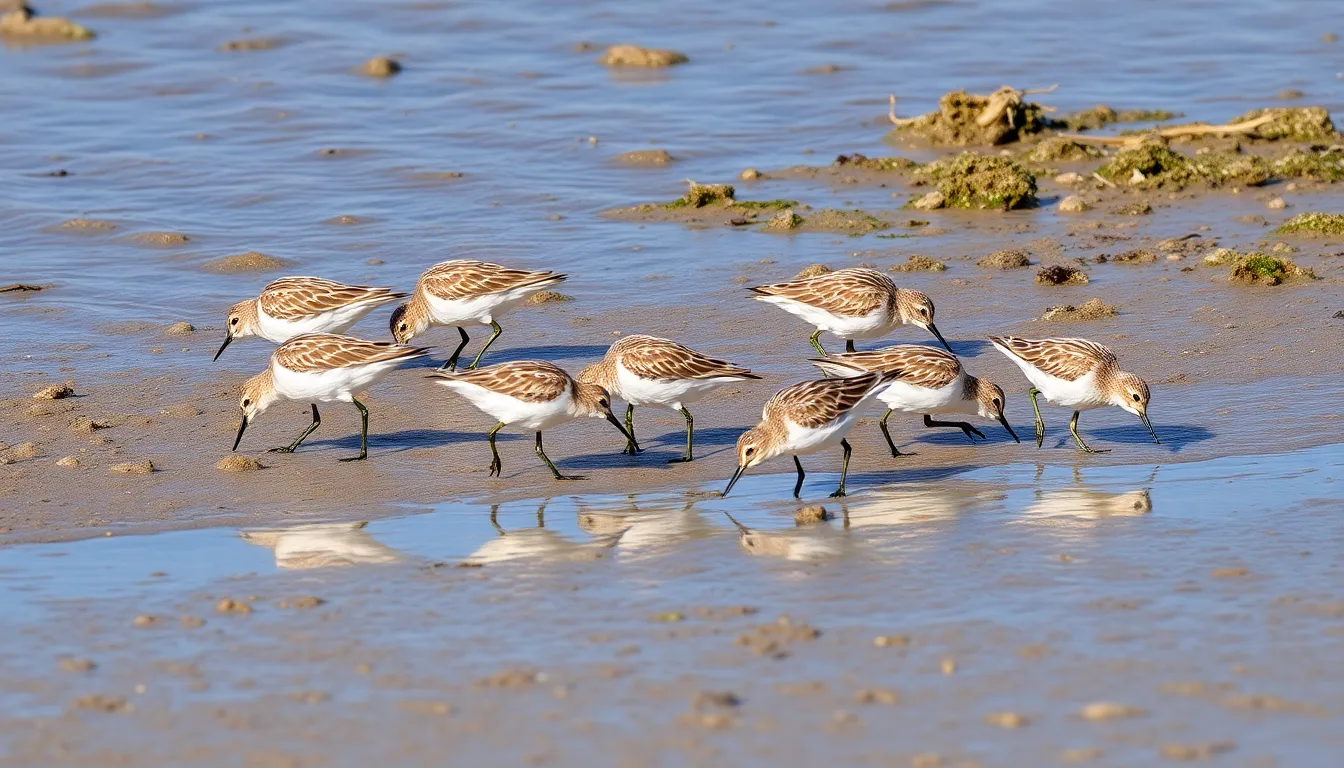
Sandpipers demonstrate remarkable behavioral adaptations that enable their survival across diverse environments. Their feeding strategies and social dynamics reflect millions of years of evolutionary refinement.
Feeding Habits and Foraging Techniques
Sandpipers employ specialized foraging techniques that maximize their feeding efficiency in mudflats and shallow waters. We observe three primary feeding methods: probing, surface gleaning, and tactile feeding through sensitive bill tips.
Probing techniques vary significantly among species based on bill morphology. Dunlin species probe 1 to 2 inches deep in soft sediments using their slightly curved bills. Least Sandpipers employ rapid shallow probes measuring 0.5 inches deep to capture surface invertebrates. Red Knots use powerful bills to extract clams buried 3 to 4 inches beneath the substrate.
Surface gleaning occurs when sandpipers pick prey directly from exposed surfaces during low tide periods. Sanderlings demonstrate this technique by running along wave edges and capturing amphipods, marine worms, and small crustaceans. Spotted Sandpipers learn insects from rocky surfaces and vegetation borders adjacent to water bodies.
Tactile feeding relies on specialized nerve endings in bill tips that detect buried prey through vibrations. Western Sandpipers locate polychaete worms and small mollusks using this sensory adaptation. Semipalmated Sandpipers identify amphipods and chironomid larvae through substrate vibrations detected by their sensitive bills.
| Foraging Method | Depth Range | Primary Prey | Species Examples |
|---|---|---|---|
| Deep Probing | 2-4 inches | Clams, large worms | Red Knot, Turnstone |
| Shallow Probing | 0.5-2 inches | Small invertebrates | Dunlin, Least Sandpiper |
| Surface Gleaning | Surface only | Amphipods, insects | Sanderling, Spotted Sandpiper |
| Tactile Detection | Variable | Hidden prey | Western Sandpiper, Semipalmated |
Social Behavior and Flocking
Sandpipers exhibit complex social behaviors that enhance their survival during migration and feeding periods. Flocking dynamics change dramatically between breeding and non breeding seasons based on resource availability and predation pressure.
Mixed species flocks form regularly during migration periods when multiple sandpiper species converge at stopover sites. Delaware Bay supports flocks containing 50,000 to 100,000 individuals representing 15 different species during peak migration weeks in May. Copper River Delta hosts similar concentrations with Western Sandpipers, Dunlin, and Least Sandpipers forming temporary associations.
Feeding hierarchy emerges within mixed flocks based on body size and bill length differences. Larger species like Red Knots dominate prime feeding locations along tide lines. Smaller species including Least Sandpipers and Semipalmated Sandpipers use marginal areas with different prey densities.
Roosting behaviors demonstrate sophisticated social organization during high tide periods when feeding areas become submerged. Sandpipers form dense roosting aggregations containing 10,000 to 30,000 individuals on protected beaches, salt pond islands, and elevated mudflat areas. These roosts provide protection from aerial predators through collective vigilance systems.
Communication patterns include distinct vocalizations and visual displays that coordinate flock movements. Dunlin produce sharp “kreep” calls that signal danger to nearby individuals. Sanderlings use soft contact calls during feeding to maintain flock cohesion while foraging along ever-changing shorelines.
Breeding territory behaviors contrast sharply with gregarious non breeding patterns. Male Spotted Sandpipers establish territories measuring 100 to 200 meters along stream corridors. Arctic breeding species like Red Knots defend smaller territories of 50 to 75 square meters on tundra nesting grounds.
Breeding and Reproduction
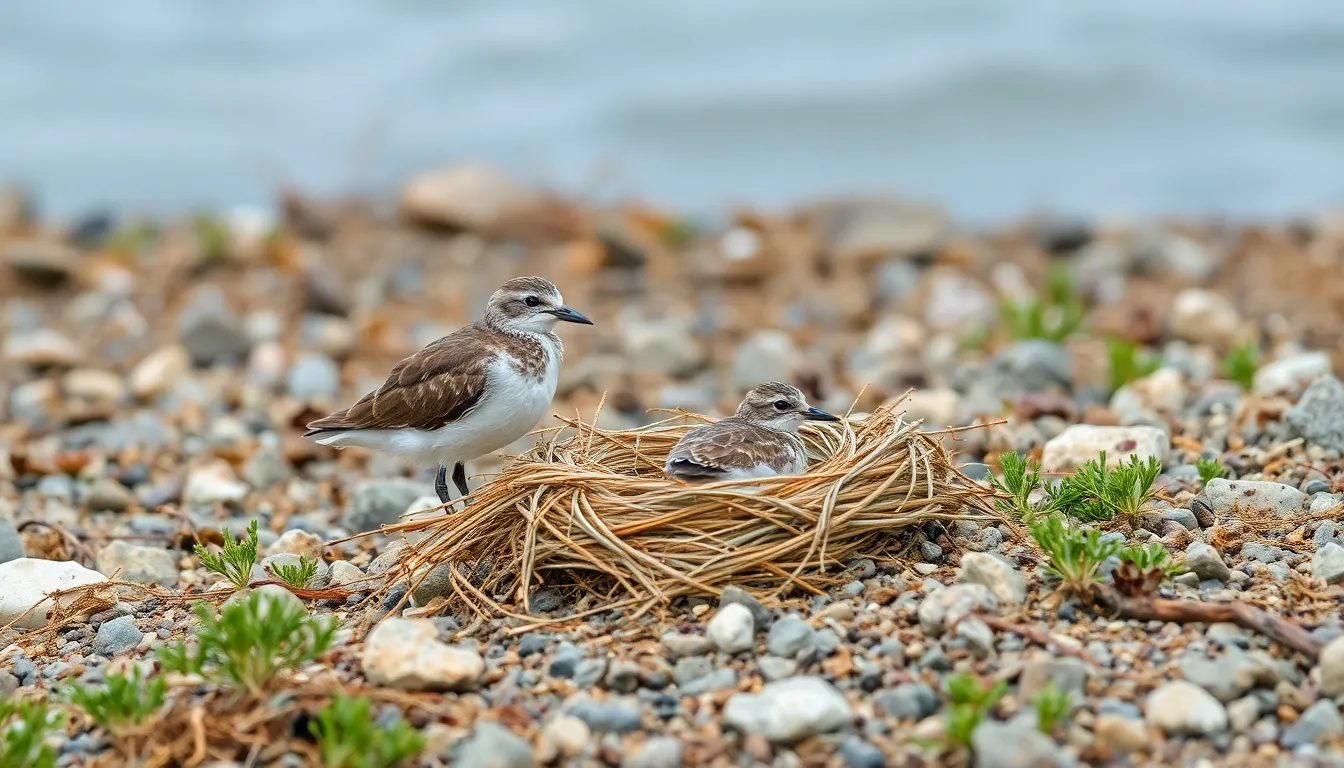
Sandpiper breeding cycles follow precise seasonal patterns that maximize reproductive success across diverse habitats. These remarkable shorebirds demonstrate sophisticated reproductive strategies adapted to their exact environments and migration schedules.
Nesting Preferences
Sandpipers construct their nests in carefully selected ground locations that provide optimal protection and camouflage. Arctic breeding species like the Red Knot choose elevated tundra sites with sparse vegetation, creating shallow scrapes lined with lichens, moss, and small stones. Coastal species such as the Least Sandpiper prefer salt marsh edges and dune grass areas where vegetation provides natural concealment.
Nest construction involves both males and females working together to create a simple depression measuring 3 to 4 inches in diameter. The scrape depth ranges from 1 to 2 inches, with parents adding natural materials including dried grasses, leaves, and feathers as lining. Ground nesting locations offer advantages including easy access to foraging areas and reduced visibility to aerial predators.
Different species show distinct habitat preferences during nesting season:
- Spotted Sandpipers select gravel bars and rocky shores near freshwater sources
- Dunlin favor wet meadows and sedge marshes in Arctic regions
- Sanderling choose dry tundra sites elevated above surrounding wetlands
- Pectoral Sandpipers prefer polygon tundra with interconnected pond systems
Nest site selection occurs within 24 to 48 hours of arrival at breeding grounds, with pairs defending territories ranging from 2 to 15 acres depending on species size and resource availability.
Mating Rituals and Chick Care
Sandpiper courtship displays combine aerial acrobatics with ground based performances that establish pair bonds and territorial boundaries. Males initiate courtship through elaborate flight patterns featuring rapid wing beats, steep dives, and distinctive vocalizations that carry across breeding territories.
Ground displays involve males approaching females with lowered heads, spread tail feathers, and rhythmic stepping motions. The Spotted Sandpiper performs unique “butterfly flights” with exaggerated wing movements 15 to 20 feet above ground level. Pectoral Sandpipers inflate throat sacs to produce resonant hooting calls audible from distances exceeding 1 mile.
Pair formation typically occurs within 3 to 7 days of territorial establishment, with monogamous bonds lasting throughout the breeding season. Females lay clutches containing 4 eggs in most species, though some Arctic breeders produce 3 egg clutches in response to shorter breeding windows.
Incubation periods vary among species:
| Species | Incubation Period | Parental Care |
|---|---|---|
| Least Sandpiper | 19-23 days | Both parents |
| Dunlin | 21-24 days | Both parents |
| Sanderling | 24-26 days | Male dominant |
| Red Knot | 22-24 days | Both parents |
Chick development follows precocial patterns with young birds leaving nests within 2 to 4 hours of hatching. Parents guide newly hatched chicks to nearby foraging areas while providing protection from predators and weather extremes. Adult birds perform distraction displays including “broken wing” acts to divert threats from vulnerable offspring.
Fledging occurs 16 to 21 days after hatching, with parents continuing to provide guidance and protection for an additional 7 to 14 days. Young sandpipers develop adult foraging skills through observation and practice, gradually becoming independent before fall migration begins.
Sandpiper Bird Watching Tips

Sandpiper bird watching requires strategic planning and keen observation skills to successfully spot these remarkable shorebirds. We’ve compiled essential techniques and timing strategies to maximize your sandpiper encounters.
Best Times and Locations
Migration periods offer the most rewarding sandpiper viewing opportunities during spring (April through May) and fall (July through October). Peak activity occurs 2-3 hours before and after high tide when birds concentrate on exposed mudflats and feeding areas.
Optimal Viewing Times:
| Season | Peak Months | Daily Window |
|---|---|---|
| Spring Migration | April-May | Dawn to 10 AM |
| Fall Migration | July-October | 6 AM-9 AM, 4 PM-sunset |
| Winter Residents | November-March | Mid-morning tide cycles |
Coastal mudflats provide the richest sandpiper concentrations during migration seasons. Delaware Bay hosts over 425,000 Red Knots annually during May peak migration periods. The Copper River Delta in Alaska supports 5 million shorebirds including 12 sandpiper species during spring passage.
Prime Sandpiper Locations:
- Salt marshes with tidal pools
- Rocky intertidal zones
- Shallow lagoons and estuaries
- Freshwater pond edges
- Airport retention ponds
- Sewage treatment facilities
Weather patterns significantly influence sandpiper visibility and behavior. Overcast conditions with light winds create ideal viewing scenarios as birds remain active throughout daylight hours. Strong onshore winds concentrate feeding birds in protected coves and back bays.
Identification Challenges
Size comparison proves essential when identifying mixed sandpiper flocks since 15+ species often feed together during migration. We recommend using nearby objects like rocks or driftwood as reference points to gauge relative bird dimensions.
Common Identification Pitfalls:
| Challenge | Solution Method |
|---|---|
| Similar sized species | Focus on bill length/curve |
| Seasonal plumage changes | Compare leg color and posture |
| Mixed species flocks | Isolate behavioral differences |
| Juvenile vs adult birds | Note overall coloration patterns |
Bill shape variations provide the most reliable identification markers among sandpiper species. Least Sandpipers display thin straight bills measuring 0.7 inches while Dunlin exhibit curved bills extending 1.3 inches in length. Red Knots feature robust straight bills perfectly adapted for crushing molluks and crustaceans.
Behavioral cues distinguish species more effectively than plumage patterns during non-breeding seasons. Sanderlings chase retreating waves in characteristic stop-and-go movements while Spotted Sandpipers exhibit constant teetering motions when stationary. Stilt Sandpipers wade belly-deep in water unlike other species that prefer shallow edge feeding.
Leg color serves as a secondary identification tool particularly useful for distant observations. Least Sandpipers show bright yellow legs contrasting with their brownish plumage. Dunlin display black legs during all seasons while Sanderlings exhibit dark gray to black leg coloration.
- Bill length relative to head size
- Feeding behavior patterns
- Habitat preferences within the same area
- Flight call notes
- Leg and foot coloration
- Overall body proportions
Conservation Status and Threats
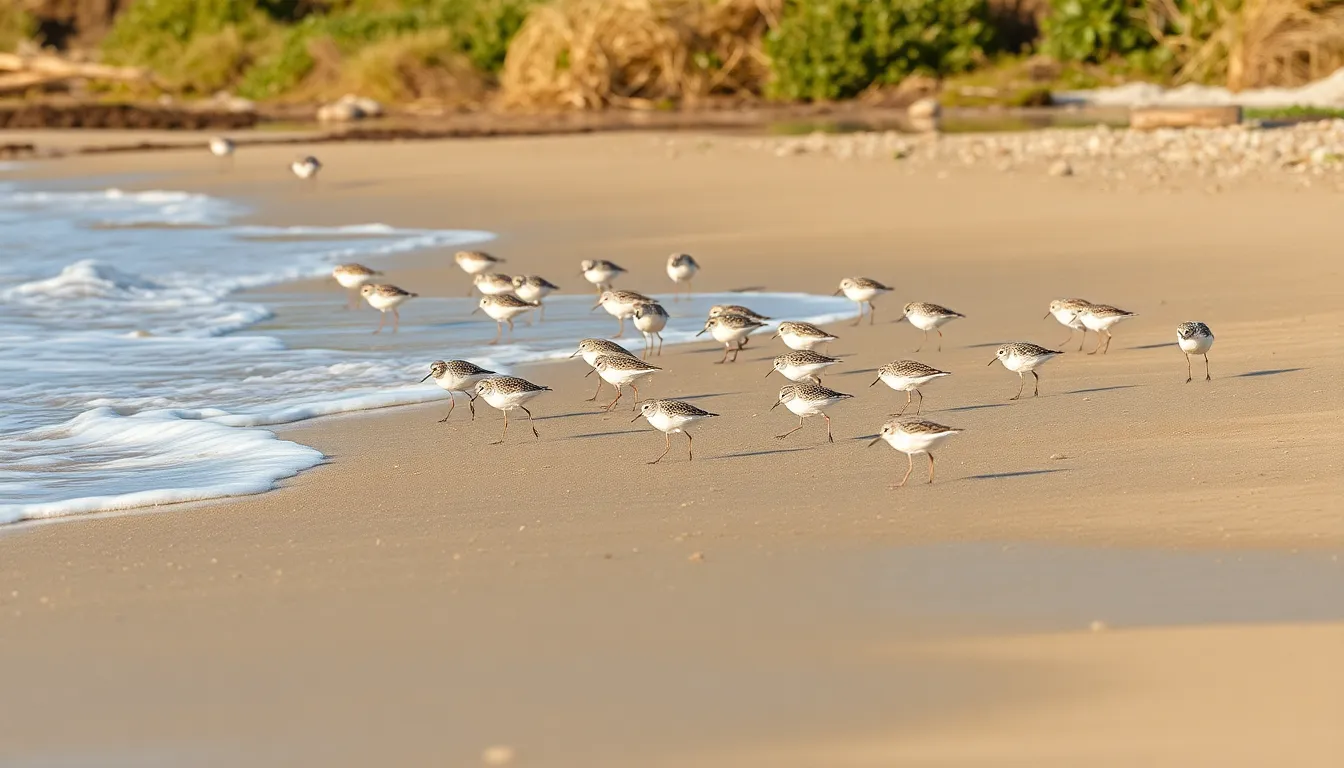
Sandpiper bird populations face mounting pressures across their global ranges, with several species experiencing important declines over recent decades. Climate change poses the most pervasive threat to these remarkable shorebirds, altering the timing of their extensive migrations and disrupting established feeding patterns along critical stopover sites.
Population Trends Across Species
Current sandpiper bird monitoring data reveals concerning population trajectories for many species worldwide. The Red Knot has experienced a 75% decline in numbers since the 1980s, primarily due to overharvesting of horseshoe crabs along Delaware Bay, their crucial stopover location. Dunlin populations in North America have decreased by approximately 60% over the past 50 years, while European Dunlin numbers show similar downward trends.
Least Sandpiper populations remain relatively stable compared to other species, though localized declines occur in exact regions. Sanderling numbers have dropped by 25% globally since 1973, with Pacific Coast populations showing the steepest declines. Spotted Sandpiper breeding populations have decreased by roughly 40% across their North American range.
Habitat Loss and Degradation
Coastal development represents a primary threat to sandpiper bird habitat, with over 80% of original salt marsh ecosystems lost in some regions. Wetland drainage for agriculture has eliminated millions of acres of inland stopover sites that sandpipers depend on during migration. Urban expansion along coastlines continues to fragment critical feeding areas, forcing these birds into smaller, less suitable habitats.
Sea level rise accelerates the loss of mudflats and sandy beaches where sandpipers forage for invertebrates. Storm intensity increases destroy nesting sites and alter sediment patterns that support their prey base. Pollution from agricultural runoff creates dead zones in coastal waters, reducing the abundance of marine worms and crustaceans that sustain migrating flocks.
Conservation Efforts and Protection Status
International conservation partnerships coordinate sandpiper bird protection across multiple countries and flyways. The Western Hemisphere Shorebird Reserve Network designates critical sites throughout the Americas, providing enhanced protection for key habitats. Partners in Flight initiatives focus on monitoring populations and identifying conservation priorities for declining species.
Several sandpiper species receive formal protection under national legislation and international agreements. The Endangered Species Act protects the Red Knot rufa subspecies in the United States, while the Migratory Bird Treaty Act covers all sandpiper species. European Union directives provide habitat protection for Eurasian species through the Natura 2000 network.
Conservation organizations carry out targeted management strategies at essential stopover sites, including horseshoe crab protection programs and prescribed timing of beach activities during peak migration periods. Habitat restoration projects recreate lost wetlands and improve existing sites through invasive species removal and water level management.
Conclusion
We’ve explored the remarkable industry of sandpipers and discovered why these shorebirds deserve our admiration and protection. Their incredible adaptations and epic migrations showcase nature’s ingenuity at its finest.
As we face mounting environmental challenges these resilient birds remind us of our responsibility as stewards of coastal and wetland ecosystems. Every conservation effort we support today helps secure their future.
Whether you’re planning your next birding adventure or simply appreciating wildlife from afar we encourage you to keep watching for these amazing creatures. Their presence enriches our natural industry in countless ways.
The next time you visit a shoreline take a moment to observe the graceful sandpipers dancing along the water’s edge. You’ll witness millions of years of evolution perfectly adapted to life between land and sea.
Frequently Asked Questions
What are sandpipers?
Sandpipers are small to medium-sized shorebirds belonging to the Scolopacidae family. They are characterized by their graceful movements along coastlines, slender builds, long pointed wings, and specialized bills for foraging. With over 85 species worldwide, they represent one of the most diverse groups of shorebirds, ranging from 6 to 12 inches in length.
Where do sandpipers live?
Sandpipers thrive in coastal areas, wetlands, mudflats, and marshes worldwide. They inhabit diverse environments from Arctic tundra during breeding season to tropical coastlines during winter. Different species prefer specific habitats – some favor sandy beaches, others rocky shores, and many utilize inland wetlands and muddy areas rich in invertebrates.
How far do sandpipers migrate?
Sandpipers undertake remarkable long-distance migrations, with some species traveling over 9,000 miles annually. They follow major flyways like the Pacific and Atlantic routes, making incredible journeys between Arctic breeding grounds and southern wintering areas. These migrations are among the most impressive in the bird world.
What do sandpipers eat?
Sandpipers primarily feed on invertebrates they extract from sand, mud, and shallow water using their specialized bills. Their diet includes marine worms, small crustaceans, mollusks, insects, and larvae. Different bill shapes allow various species to access food at different depths and locations within their habitat.
How can I identify different sandpiper species?
Sandpiper identification relies on size, bill shape, leg color, plumage patterns, and behavior. Key features include body dimensions (6-12 inches), seasonal plumage changes from vibrant breeding colors to muted winter tones, and distinctive behaviors like the Sanderling’s wave-chasing or Spotted Sandpiper’s teetering motion. Bill length and curvature are crucial identification markers.
Are sandpipers endangered?
Many sandpiper species face significant conservation challenges. Some populations have declined dramatically – Red Knots decreased 75% since the 1980s, and North American Dunlin populations dropped 60%. Threats include habitat loss, coastal development, climate change, and pollution. Several species like the Spoon-billed Sandpiper are critically endangered.
What are the smallest and largest sandpiper species?
The Least Sandpiper is the smallest North American shorebird, measuring about 6 inches in length and weighing around 0.5 ounces. Larger species like the Red Knot can reach up to 12 inches and weigh up to 8 ounces. Size variations reflect different ecological niches and feeding strategies within the sandpiper family.
When is the best time to see sandpipers?
The best times to observe sandpipers are during spring and fall migrations (April-May and August-October) when large numbers congregate at stopover sites. Early morning and late afternoon provide optimal viewing conditions. Coastal areas, mudflats, and wetlands during low tide offer excellent opportunities to observe their feeding behaviors and social interactions.

